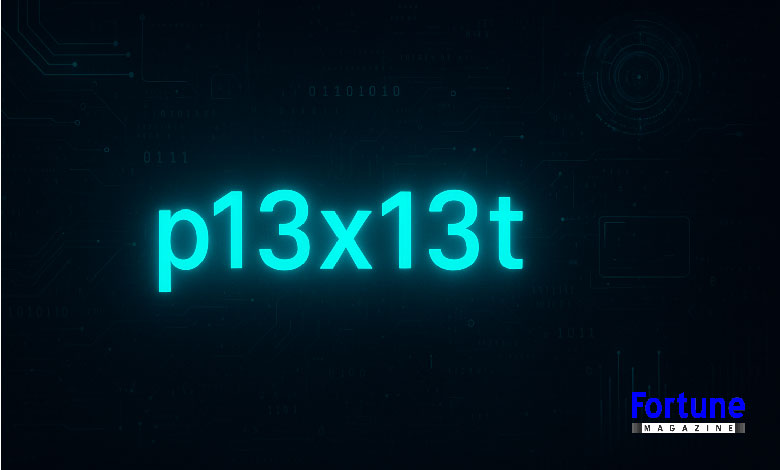p13x13t: Decoding the Enigmatic Digital Identifier

In the world of modern technology, where every detail seems meticulously planned and cataloged, few things escape definition. However, one identifier, “p13x13t,” continues to intrigue and mystify those who come across it. At first glance, it may appear as a random alphanumeric string, an obscure sequence of letters and numbers—perhaps a forgotten password or a technical code. Yet, p13x13t holds a deeper meaning, one rooted in digital anonymity, cryptography, and a long-standing connection with experimental technology. In this article, we will explore the enigmatic nature of p13x13t, breaking it down, examining its history, its connection to modern technologies, and the theories surrounding its true purpose.
What is p13x13t?
p13x13t is no ordinary identifier. It is not a term that can be easily defined or explained through a simple dictionary entry. The combination of letters and numbers has appeared across different digital platforms, from obscure forums and experimental code repositories to avant-garde digital art installations. Its structure—”p,” followed by “13×13,” and ending with “t”—suggests a complex, intentional design, and its mystery only adds to its allure.
The Structure of p13x13t
- p: Often used as a prefix in technical jargon, “p” could signify “process,” “protocol,” or be used as a marker in a sequence of data or instructions.
- 13×13: This is the most curious part of p13x13t. The “13×13” is typically interpreted as a reference to a 13×13 grid or matrix, totaling 169 units. In computing, this kind of grid is used in pattern recognition, pixel mapping, and neural networks. The number 13, often considered a symbol of transformation in numerology, further deepens the significance of the structure.
- t: The “t” at the end could refer to many things, including “token,” “test,” “transmission,” or even something more abstract. It could symbolize a phase in a process, a temporary state, or a signature.
Put together, p13x13t seems like a compact, multi-layered formula, encoding a deeper meaning or system that connects digital art, cryptography, AI, and other advanced technologies.
The Origins of p13x13t: A Digital Enigma
The origins of p13x13t remain largely unexplained, adding to its aura of mystery. Unlike other technical terms or identifiers, p13x13t does not have a single, definitive origin. Its first sightings were in code libraries and encryption-related digital spaces as early as 2013. Early developers and cryptographers began using the term in their code as a tag or comment. The interesting aspect is that these sightings were not coordinated; they were scattered across different digital projects, with no clear connection to one another.
Some theorists suggest that this could be a case of “digital synchronicity,” where multiple developers, unaware of each other, independently used the same tag. This is a phenomenon that can happen when innovative minds unknowingly converge on a similar idea or concept.
In the years since, p13x13t has resurfaced in many different forms—always appearing as a fragment of code, a digital marker, or a cryptic symbol within encrypted messages and digital art.
The 13×13 Grid: Mathematical and Symbolic Significance
The “13×13” portion of p13x13t is not arbitrary. The number 13 is a recurring motif across various cultures and fields, often symbolizing transformation, upheaval, and even chaos. But in the world of computing, numbers like 13×13 are deeply significant. The 13×13 matrix could represent several things:
- Quantum Computing: Quantum computers often rely on complex matrices to simulate quantum systems and their interactions. Some believe p13x13t could be a nod to quantum computing, suggesting it is tied to the development of encryption protocols in this emerging field.
- Pattern Recognition: In AI and machine learning, grids like 13×13 are used for recognizing patterns in data. Could p13x13t be linked to early AI research, acting as a test case for minimalist neural network models?
- Data Grids and Visual Representations: The grid could also represent a visual map or data block used to compress information, making it easier to process and analyze in a structured form.
p13x13t as an Artistic Digital Symbol
While p13x13t has roots in code and cryptography, its presence has recently been felt in the world of digital art. The symbol has been used as the name for several generative art projects, NFTs, and even blockchain-based audio-visual experiments. This shift from code to art speaks to the inherent abstractness of p13x13t, which lends itself well to digital surrealism and conceptual art.
Some of the artistic projects that have used p13x13t include:
- “p13x13t Fractures”: A glitch-art series in which corrupted video files are arranged in a 13×13 tile matrix, creating a fragmented visual experience.
- “p13x13t Echoes”: A sound experiment created on the blockchain, where algorithmic music is generated from hexadecimal noise patterns that mimic the randomness of p13x13t itself.
- Interactive Games: Some digital games incorporate p13x13t as a hidden element, one that can only be uncovered through unconventional actions or decisions, adding to the mystery of the identifier.
These digital artworks show how p13x13t, a seemingly random string, has evolved into a symbol of creative expression, opening new avenues for exploration in the realm of generative art and interactive design.
p13x13t as a Digital Identity Mask
One of the more intriguing ideas around p13x13t is its potential role as a digital identity system or “mask.” In cybersecurity, identity and anonymity are key themes. Traditional methods like VPNs or burner accounts obscure a user’s identity. However, p13x13t may represent something different—a “refraction” of identity that isn’t entirely invisible but shifts and changes based on the context in which it is used.
Could p13x13t Be an Advanced Privacy Protocol?
Some have speculated that p13x13t could be a new kind of protocol designed to hide digital footprints. Rather than simply deleting or masking an identity, p13x13t could be a dynamic, adaptive system—one that changes its digital signature depending on the environment. This would offer an unprecedented level of privacy and anonymity in digital spaces, while still maintaining a form of traceable identity.
The Identity Prism Theory
An anonymous researcher has even coined the term “identity prism” to describe p13x13t, suggesting that it could function as a system that refracts and distorts identity across digital platforms. Instead of providing a static, fixed digital signature, p13x13t might morph, allowing its user to move seamlessly across online spaces without leaving behind a single, recognizable trace.
p13x13t in the Age of Machine Learning
In the realm of artificial intelligence (AI) and machine learning, the appearance of identifiers like p13x13t is becoming more common. AI systems, particularly those trained on unstructured data, often generate their own forms of identifiers. These identifiers, much like p13x13t, often don’t follow conventional linguistic patterns but are born from data entropy and machine logic.
p13x13t as a Product of AI’s Spontaneous Learning
AI systems, especially those engaged in unsupervised learning, frequently generate seemingly random alphanumeric strings as part of their pattern recognition processes. This phenomenon suggests that identifiers like p13x13t may be digital artifacts created by AI systems—spontaneous combinations born from machine logic. As AI continues to evolve, identifiers like p13x13t may become more common, marking the emergence of machine-generated languages.
The Theories Around p13x13t’s Purpose
With no clear origin and no single owner, p13x13t has sparked several theories about its true purpose. Some of the most intriguing include:
The Time Capsule Theory
This theory suggests that p13x13t is part of a larger, yet-to-be-decoded message—a digital time capsule meant to be uncovered at a later date. Perhaps p13x13t is the first piece of a puzzle that, when solved, will reveal a more significant truth.
The Algorithmic Signature Theory
This theory posits that p13x13t is an algorithmic watermark or signature embedded in digital content across multiple platforms. It could be a way to track interactions between users, testing how people interact with certain content, while remaining largely hidden from most users.
A Digital Meme Theory
The idea that p13x13t could be a meme—one that evolves and spreads across digital spaces without any official endorsement or origin—has gained traction. This “conscious meme” could symbolize the randomness and chaos inherent in the digital age, where patterns emerge and shift in unpredictable ways.
Conclusion: Embracing the Mystery of p13x13t
p13x13t continues to be one of the most mysterious and captivating identifiers in the digital age. It is neither a product, a company, nor a technology—it is simply a puzzle, one that invites exploration, interpretation, and curiosity. Whether it serves as a piece of encrypted data, a work of digital art, or a protocol for digital identity, p13x13t remains a symbol of the unknown.
In a world dominated by algorithms, codes, and predictable outcomes, p13x13t offers a moment of uncertainty, a reminder that not all mysteries are meant to be solved. Instead, some are meant to be explored.




